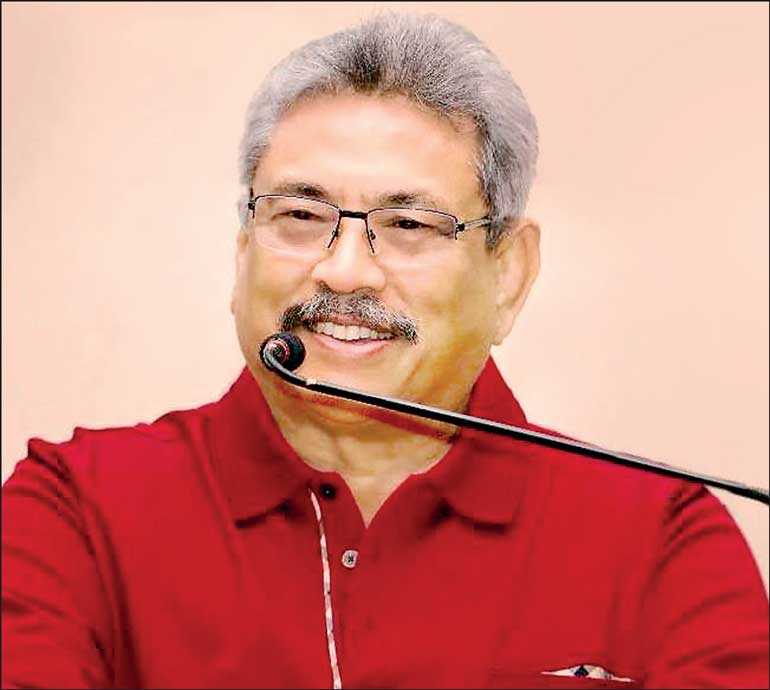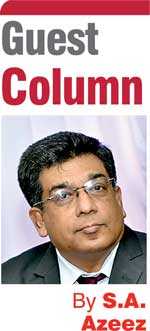Friday Apr 04, 2025
Friday Apr 04, 2025
Tuesday, 26 November 2019 00:00 - - {{hitsCtrl.values.hits}}

Our country has been experiencing slow economic growth in the recent past. We have recorded one of the lowest growth rates in South Asia. The new President faces the inevitable challenge of finding the correct approaches to stimulate the economy and achieve high economic growth.
Some countries have resorted to various forms of tax cuts to boost economies and attract investment. Even USA and India have done this in the recent past.
The present tax regime may be one of the causes hindering economic activity and investment in the country. Tax compliance has become a herculean task for an average entity. One has to decide whether to do business or spend most of his or her time on tax compliance matters.
To increase tax revenue substantially and equitably in the medium to long term, the main focus has to be on widening the direct tax base instead of heaping the burden on existing taxpayers by raising these taxes. In this country, there is a large informal economy and a huge tax base to pay direct taxes but only a small fraction pays direct taxes. Ways and means have to be found to bring the large proportion of people who are capable of paying income tax but not paying any tax, in to the tax net. Today even a plumber earns more than Rs. 2,500 per day and his annual earnings would easily exceed tax free thresh hold of Rs. 500,000.
There is a perception that the proportion of indirect taxes to direct taxes be reduced substantially within short period of time in order to achieve equitable tax regime. One has to be mindful of the fact that main component of indirect taxes in this country consist of taxes (including Customs duties) imposed on liquor, tobacco and other luxury items. Essential items such as main food items and medicines are basically exempted from these indirect taxes.
When introducing a tax or changing a tax it should not leave any room for tax avoidance and evading. For example an individual taxpayer is entitled to Rs. 500,000 tax free allowance per year. An employee of a company is entitled to Rs. 1,200,000 tax relief.
Situations like this may give rise to various forms of tax avoidance.
Some of the anomalies in the current tax regime will have to be rectified by the new Government
Small and Medium Enterprises (SMEs)
According to the Inland Revenue Act of No. 24 of 2017 SMEs are entitled for concessionary tax rate of 14%. However, SMEs which are associate entities have been excluded from the concessionary rate. The term associate has been very broadly defined. Therefore, many SME entities fall in to the higher rate of 28% though in many cases even the combined turnover is less than stipulated minimum of Rs. 500 million.
Interest and penalties
Under the current Act, interest on tax in disputes can be as high as 20% per annum. The penalty imposed on non-compliance is prohibitively high in many instances. The system automatically calculates penalties. Huge penalty burdens along with tax liabilities may undermine many businesses in the medium to long term.
Ability to pay is one of the main principles of taxation. This principle is applicable to event penal charges imposed by Revenue authorities.
The Commissioner General must be given powers to determine interest and penalties fairly under just and equitable circumstances.
Professionals
Sri Lanka is a developing country. Successive governments attempted to retain skilled professionals in this country without moving out to more lucrative developed countries by providing various incentives. Any country cannot succeed in social or economic fronts without the contribution of professionals and intellectuals. In the past professionals were taxed with a ceiling of 16%. This concessionary rate has been removed and professionals have been brought under the normal maximum rate of 24%.
Economic Service Charge
Economic Service Charge (ESC) was introduced in 2004 to recover some tax in lieu of income tax from those entities that were exempt from income tax and those who were declaring loses in the accounts. In fact, this was done to recover loss of revenue due to tax exemptions, tax evasions and avoidance during that period.
Though ESC is related to turn over the intention was to collect a tax where income tax is not paid. Later ESC was made liable for even entities liable for income tax. However, ESC was allowed to be deductible from income tax liability. ESC could be carried forward and set off for 4 years against income tax. In addition, there was a maximum limit of Rs. 250,000,000 for ESC liability. The intention of the law in relation to income tax liable entities, was to facilitate deductions of ESC to a large extent from income tax and thereby avoid double taxation.
According to current ESC regime there is no maximum limit on ESC liability. ESC carried forward is allowed only for three years. Further, the rate has been raised to 0.5% on the turnover of almost all business entities with the turnover of more than Rs. 12,500,000 per quarter. The component of ESC which cannot be deductible from income tax becomes a cost for business and in turn this may be passed on to customers. ESC which started with the features of income tax (Direct tax) is increasingly becoming an indirect tax such as VAT and NBT.
With Holding Taxes
Currently, WHT tax is applicable on employment income, interest, rents, fees, partnership income, etc.
WHT on rent is liable on any amount even, say Rs. 2,000 per month. Even if the income of the landlord is less than the statutory tax-free allowance of Rs. 500,000, still WHT has to be deducted.
There are no provisions to get directions from the Department to stop such deductions. One segment of the society is charged with income tax though their income is less than statutory tax-free limit making an inequitable element in the current system. Though there is a proposal to fix a minimum limit on rent of Rs. 50,000 per month this has still not been implemented
WHT on fees also needs to be revisited. Currently a fee of Rs. 50,000 or more paid by a business to an individual will be subject to a WHT of 5%.
This person may not be an income tax liable person getting an income exceeding Rs. 500,000 per year. The Rs. 50,000 payment may even be a one off payment.
Even if a single person provide his services through a registered proprietorship he is subject to WHT while two or more people provide services through a partnership or a company such fees are not subject to WHT.
Similarly, partnership income is also liable to WHT irrespective of the amount. Earlier there was a limit of Rs. 1,000,000 for a partnership to be liable for income tax. Presently no such tax-free limits exist for deduction of WHT and even an income of say Rs. 5,000 will be liable to WHT at 8% when allocating such profit to partners. If a partnership business earns an income of Rs. 1,100,000 in 2017/18, the partnership tax liability is Rs. 8,000. If this partnership has the same income for 2018/19, it will be liable to deduct a WHT of Rs. 88,000, in other words income tax attributable to partners.
If the partners do not have any other income and the profit is shared equally there will be an over payment of Rs. 80,000. Startup entrepreneurs will be in difficulties if no minimum limit is set for WHT on partnership income. Partnership have to pay ESC too without any setting off entitlement against WHT.
Thin capitalisation
This rule restricts the deductibility of interest expenses in calculating income of an entity for tax purposes. The restriction is based on capital (Equity) to loan ratio with capital taken three or four times depending on manufacturing or non-manufacturing activity. Many companies run on losses for many years and may be highly indebted.
Their balance sheets may show very low total of capital and reserves or even a negative figure due to accumulated losses. In such circumstances a company may not be able to deduct the interest expenses in the year they are incurred. Paradoxically, an entity may end up with an income for tax purposes despite actual losses due to the inability to deduct such expenses in the production of income.
(The writer is a Chartered Accountant and can be reached via email at [email protected].)
Discover Kapruka, the leading online shopping platform in Sri Lanka, where you can conveniently send Gifts and Flowers to your loved ones for any event including Valentine ’s Day. Explore a wide range of popular Shopping Categories on Kapruka, including Toys, Groceries, Electronics, Birthday Cakes, Fruits, Chocolates, Flower Bouquets, Clothing, Watches, Lingerie, Gift Sets and Jewellery. Also if you’re interested in selling with Kapruka, Partner Central by Kapruka is the best solution to start with. Moreover, through Kapruka Global Shop, you can also enjoy the convenience of purchasing products from renowned platforms like Amazon and eBay and have them delivered to Sri Lanka.
Discover Kapruka, the leading online shopping platform in Sri Lanka, where you can conveniently send Gifts and Flowers to your loved ones for any event including Valentine ’s Day. Explore a wide range of popular Shopping Categories on Kapruka, including Toys, Groceries, Electronics, Birthday Cakes, Fruits, Chocolates, Flower Bouquets, Clothing, Watches, Lingerie, Gift Sets and Jewellery. Also if you’re interested in selling with Kapruka, Partner Central by Kapruka is the best solution to start with. Moreover, through Kapruka Global Shop, you can also enjoy the convenience of purchasing products from renowned platforms like Amazon and eBay and have them delivered to Sri Lanka.